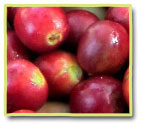Epicurean Coffee Blending
Coffee is the seed inside the fruit (“cherry”) of a tender plant cultivated in tropical climates. Like all agricultural products its growth is regulated by terroir variables such as climate, elevation, annual rainfall, soil composition, sunshine, and available nutrients. Once the cherries mature, methods of processing like harvesting, depulping, drying, interim storage, milling, sorting, and final preparation also leave their distinctive marks on the flavor of the crop. Thus the coffee universe provides us with a fantastically rich and diverse selection of coffees to roast.

These green coffee photos from our roastery inventory show examples of typical variation in top quality coffees. Of course they can’t tell you how the final coffee will taste in your cup, nor how fresh or aromatic the crop is, but an experienced roaster learns a great deal from them.
The first thing a roaster checks is that there are no discolored, broken, or clunker beans, or other matter which could spoil the flavor of the whole batch. Such a sample would be rejected out of hand. When previewing a green sample we look for the cleanliness of the preparation, uniformity and fullness of bean shape, size, and color — all clues to how fully the coffee has ripened and how evenly it will roast.
Wet versus Dry Processing
 One of the great differentiators between raw coffees is the method used by the grower to strip the outer pulp and hulls from the coffee cherry and get at the coffee seed or “bean” encapsulated inside. For many reasons the wet or washed method is the commercial standard but there will always be roasters who demand the unique character of dry processed coffees.
One of the great differentiators between raw coffees is the method used by the grower to strip the outer pulp and hulls from the coffee cherry and get at the coffee seed or “bean” encapsulated inside. For many reasons the wet or washed method is the commercial standard but there will always be roasters who demand the unique character of dry processed coffees.
You can observe in the above green bean photos some of the difference between washed coffees (like El Salvador, Nicaragua, and Timor), semi-washed (like Sumatra), and natural preparations (like Ethiopian). Note the uniform size, color, and smooth surfaces of the washed beans, the deep jade hues of the pulp-soaked Sumatra, and the irregularities and bits of silver skin still present on the natural, dry-milled Ethiopians.
Such slight variations at this high level of quality are expected. They don’t tell you whether one coffee will cup better than the other, but that they are likely to cup true to their expected regional characteristics of body, acidity, fruitiness.
Single Origin versus Blends: Knowledge versus Pleasure?
In thinking about blending one question we sometimes ask ourselves is do we drink coffee to experience the character possessed by individual growths, or is it to satisfy our personal taste preferences? The answer for us at least has to be “both”, at different times and for different reasons. We drink single growths because we enjoy them and to satisfy our quest for higher granular knowledge of origins. And we blend origins and roasts together to explore our personal thirst for epicurean coffee drinking. In the end all coffee drinking is for pleasure and teaches us something about ourselves.
When selecting green coffees to blend before roasting we pick some for the body they will give to the cup, some for other flavor characteristics (like fruitiness) and still another for the acid balance. Always the goal in blending is to build a cup of brewed coffee that is harmoniously balanced, lively on the tongue, and rich in flavors and aroma.
The reasons for blending green beans are similar to the goals in blending roasted coffees. However since roasting amplifies differences in green beans blending roasted coffees yields a much wider range for contrast and complexity than simply blending green coffees in a single roast.

The Essential Whoosh
Through operation of the Maillard (browning) reaction, roasting coverts the amino acids and sugars in the green beans into what we at Coffee Works like to call the essential whoosh: That tantalizingly complex and fugitive explosion of tastes and aromas that is fresh coffee.
Coffee roasting is a simultaneous act of both creation and destruction. When roasting we transform a somewhat dull, inherently bitter (mostly from the caffeine) seed pit into a fragrant taste delicacy. In the process we toast out the bitterness and convert its raw substance into sweet caramels and volatile organic aromas. Simultaneously, by popping it out of its protective hull we expose all of it to oxygen, which means that the clock starts ticking.
The Moment of Perfection

There is but a moment of perfection in the life of a roasted coffee bean. Once roasted, coffee must be enjoyed while the flavors are at or near their peak of freshness, before they have fulfilled their molecular imperative to become one with the universe.
Before that happens, depending on the roaster’s final set point, the whoosh varies from the mild caramelization of light roast, through all the middle tones of Maillardville, until it finally reaches the extreme toasting of our dark French Italian roast. Thanks to our fluidized bed roasting technology we can control the final degree of roast precisely, to produce sweet dark roasts without a hint of charring or bitterness.
As the roasted coffee photos show, this roast spectrum is wide and provides a rich palate of flavors for composition. By combining two or more roasts we can include a wider range of coffee flavors in a single blend; Possessing more contrast, complexity, and resonance than any single roast or origin.
After thirty years of post-roasting blending this handful of distinctive house blends has become a style of our own.
Coffee Works style is embodied in our trademark blends: Sweetfire, Jump Start, Balthazar’s, and Dark Star. They encompass light to dark roasts and all the hues between. They showcase some of our favorite coffee origins; each roasted to what we consider their optimal development, and then combined into complementary liaisons. We invite you to explore them all in the descriptions on our menu, and by the only true test of coffee goodness: The taste in your cup.

